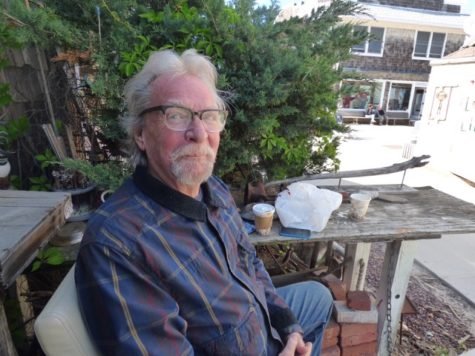Kenny Goodman has been a staple on Fire Island for decades. Most know him by his tiny shop of treasures in Ocean Beach, where Island goers can browse through his original silver jewelry pieces known as “Kennys.” He is most famous for carved face pendants, but his work runs the gamut from ankle bracelets to rings and necklaces, each unique and as original as he is.

Fire Island News: What impact do you think you’ve made on the people of Fire Island?
Kenny Goodman: I think my overall impact on the people has just been this: they were looking to know someone and like someone and I was looking to be known and liked. That’s pretty much how it all fit together. The art form was our introduction. They would see me do it, going back to when I was 22 years old in the summers. While I love the outdoors, I don’t care for the beach. So I would work outside my house, because the woodcarvings I did were massive. I like talking. So people would come by, kids and everybody, because I would plop myself right in the middle of central walk in Fair Harbor where I’d lived and started. Each piece took me anywhere from four to six weeks, and every day they would watch the progress. The most common question was: How do you do it? So I wound up coming up with the slogan, “What you know is easy. What you don’t know is hard. What you learn becomes easy and what you forget becomes hard.” I just knew how to do it. I don’t know how I know how to do it. It was by process and repetition. The first one was nowhere close to the refinement that ultimately, years later, it turned into.
FIN: Do you have any influences that have directed your life?
KG: An enormous influence in my life was the book “The Little Prince.” As I read it, each chapter became, “Yeah! That’s exactly how I feel!” The first time I read it was my first summer on Fire Island. I was maybe 21 or 22. Each little segment, starting from grownups never understand all the way through to the most significant part, which was the uniqueness of the rose. He described adults. They only understand numbers, so if you say to an adult, I just bought a new house, they only understand if you say, it’s a $350,000 house, but a child understands if you describe the house as a beautiful pink house with a fence and flowers planted. That’s the difference. Adults lose the power of their imaginations. They no longer feel the wonder of childhood. Believe that. I live that way. And it resonated when I read the author writing about it.
FIN: What is your legacy?
KG: What do I leave behind? I would like to think that it’s a sense of individuality. I am not a fan of groups. Any groups. I don’t like groups. I have difficulty with religion because it tends to be groups. And while not everybody feels this way, there’s a tendency to think my god is the right god. With individuals, it has to do with who you are and what you’ve accomplished, not your ancestors or coming from New York or being a Giants fan or any of those things. It has to do with you. That concept inspired me to make the freedom pendant. I named it the Torch of Freedom for Individual Excellence. And freedom to me means free to be the best person you could be. Not your background, not your ancestors, not your country – you. A young man who grew up playing the saxophone may eventually go to law school. Go be a lawyer. But don’t lose the saxophone. Don’t lose your passion.
FIN: Your career in the non-summers was in education as a teacher in the Bronx. What did you take away from that?
KG: Education is the transfer of information from one person to another. A successful teacher is like an actor. I think all teachers should take drama classes. Advertising is an enormously successful way of educating, if at least there was some sense of truth in advertising but it’s all one big lie, one big dramatization. It’s just an extension of those wonderful cereal or car commercials. It’s effective, so I’d like truth in advertising.
FIN: If there is no truth in advertising, is there truth in art?
KG: It depends on the artist.
FIN: Is there truth in your art?
KG: I think there’s truth in my art. I wound up thinking of myself as a jewelry maker because that’s what people buy. They don’t buy sculpture. And I certainly earned a reputation as a silver guy, but the difference between a jewelry designer and an artist is that an artist has something to say. I’ve done a number of pieces that serve a purpose besides being a trinket, such as the breast cancer awareness necklace. I have one for peanut allergies, even an autism awareness piece. So I think there’s a purpose and a truth to my art.
FIN: What kind of changes have you witnessed on Fire Island?
KG: I came to Fire Island in 1967. It’s evolved. They say the old days were better, but it was the same
crap! Young people were offensive, and old people were grumbling. I do see in Ocean Beach, not that it’s different, but young people are overcooked – just so extreme, so much drinking with little insight into how it can affect their lives. One of the changes is that when I first got out there, there was no air conditioning. There were no swimming pools. There were very few telephones in the houses and not a lot of televisions. Now air conditioners are so common that they’re looking into making rules for how to control the noise! The things that have stayed the same are young people, group houses, not paying attention to anybody else.
FIN: Tell me about your collaboration with Fire Island News on their 60th Anniversary?
KG: I’m very flattered that Fire Island News on its 60th anniversary has asked me to make a commemorative piece and be a part of this celebration. It’s their diamond anniversary, and therefore symbolic of the enduring relationship this paper and the island have with each other.































